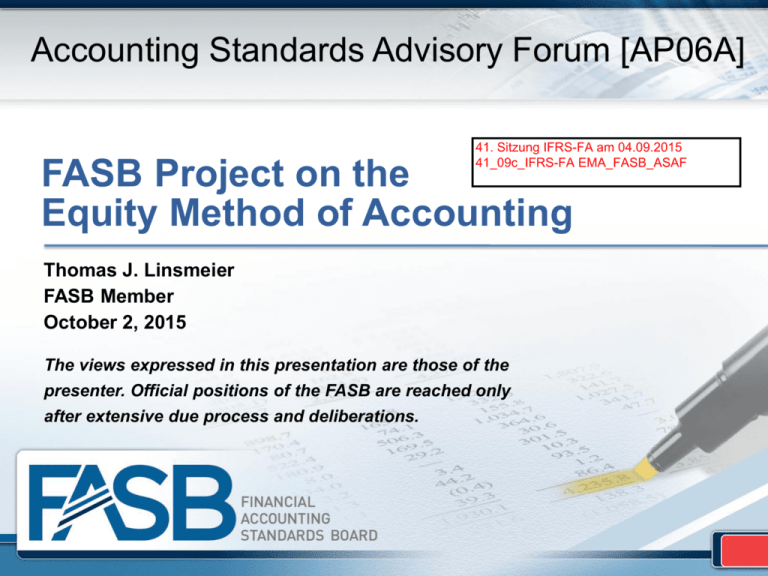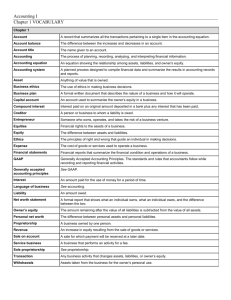Simplifying the Equity Method of Accounting
advertisement

Accounting Standards Advisory Forum [AP06A] 41. Sitzung IFRS-FA am 04.09.2015 41_09c_IFRS-FA EMA_FASB_ASAF FASB Project on the Equity Method of Accounting Thomas J. Linsmeier FASB Member October 2, 2015 The views expressed in this presentation are those of the presenter. Official positions of the FASB are reached only after extensive due process and deliberations. Accounting is complex in part because… …we haven’t answered accounting questions consistently. Why? Incomplete conceptual framework Volatility – presentation issues 1510 ASAF 06A FASB Agenda Strategy Foundation projects— preventing future complexity* Simplification projects— addressing today’s complexity * Conceptual Framework and financial statement presentation projects 1510 ASAF 06A Simplification Initiative Objective Reduce cost & complexity while maintaining or improving the usefulness of the information Projects include narrow-scope items that the FASB can complete in the short term Not always so SIMPLE!! 1510 ASAF 06A Examples of Simplification Projects Subsequent measurement of inventory – lower of cost & net realizable value (complete) Eliminating the concept of extraordinary items (complete) Accounting for fees in a cloud computing arrangement (complete) Measurement date for plan assets (complete) Presentation of debt issuance costs (complete) Balance sheet classification of debt (ED soon) Income taxes: intra-entity transfers and liability classification (ED) Share-based payment accounting improvements (ED) Accounting for measurement period adjustments in a business combination (ED) Simplifying the equity method of accounting (ED) 1510 ASAF 06A Simplifying the Equity Method of Accounting 1510 ASAF 06A Background (Current GAAP) The equity method of accounting is applied if the equity investment provides the investor with significant influence over an investment (presumed when the investor holds 20% but less than 50% of the voting stock of an investee) For investments in limited partnerships and similar entities the use of the equity method is required unless the investor’s interest is so minor that the limited partner may have virtually no influence over partnership operating and financial policies (generally 3% to 5% is considered to be more than minor) The equity method investment is presented as single line item on balance sheet 1510 ASAF 06A Background (Current GAAP) The difference at acquisition between the cost of the investment and the investor’s proportionate share of the net assets of the investee (referred to as the “basis difference”) is accounted for as if the investee were a consolidated subsidiary. - The basis difference is attributed to specific assets or liabilities by comparing the fair value of the investee’s identifiable assets acquired and liabilities assumed to the book value of those assets and liabilities - Fair value of the identifiable assets acquired and liabilities assumed is determined in the same manner as a business combination - If cost exceeds proportionate share of the book value of the net assets acquired, the basis difference is accounted for in net income in subsequent periods consistent with the accounting for the assets or liabilities to which it is attributed - Either through depreciation/amortization and impairment or through impairment only If the proportionate share of the book value of the net assets acquired exceeds the cost, the basis difference is recognized as a bargain purchase gain immediately in net income 1510 ASAF 06A Background (Current GAAP) Requires recognizing the investors’ proportionate share of investee income or loss, adjusted for: Distributions Amortization or accretion of basis difference Inter-entity profits and losses Change in ownership interest Other comprehensive income The investment is tested for impairment under the other-than-temporary impairment model (OTTI) - A series of operating losses or other facts may indicate that a decrease in fair value of the investment has occurred that is other than temporary - A decline in fair value that is other than temporary must be recognized Equity method is required to be applied retroactively when significant influence is obtained in a step acquisition - Investor must adjust the investment, results of operations, and retained earnings retroactively on a step-by-step basis as if the equity method had been in effect during all previous periods in which the investment was held 1510 ASAF 06A Proposed Update (June 2015) Basis Difference - The proposed amendments would eliminate the requirement to separately account for the basis difference for equity method investments - An entity would recognize its equity method investment at its cost and would no longer determine the acquisition date fair value of the investee’s identifiable assets and liabilities assumed - For existing equity method investments an entity would cease accounting for the basis difference as of the effective date of the guidance Retroactive application of the equity method in a step acquisition - No longer required - The investor will apply the equity method as of the date the investment becomes eligible for equity method accounting. - Applied prospectively to investments that become eligible for equity method accounting after the effective date of the guidance. 1510 ASAF 06A Basis for Proposed Update Basis Difference - Current equity method accounting is inconsistent with “single-line consolidation” The carrying value of the investment is generally not written below zero even if the book value of the net assets of the investee is below zero Investment is subject to separate impairment - No conceptual basis for accounting for as “single-line consolidation” Significant influence is not control - Current GAAP on basis difference is not being applied uniformly by all entities Retroactive Application - Is costly and time consuming - Unclear of the benefits to users - Not requiring it enhances convergence with IFRS 1510 ASAF 06A Feedback on Proposed Update Comment period ended August 4, 2015 41 comment letters received Comments from those who agreed with the proposal include - Current accounting is costly and complex and provides limited value to financial statement users - The calculation is subjective and time consuming - Impairment model reduces any concern that reduced amortization will inflate earnings - There is no conceptual basis for the current accounting 1510 ASAF 06A Feedback on Proposed Update Issues raised - Increases cost and complexity due to more frequent assessment under the other-than-temporary-impairment (OTTI) model Those who cited OTTI as a concern prefer systematic amortization of the basis difference - Not reflective of economic reality - No conceptual basis for making the changes - May increase cost to comply with certain regulatory requirements 1510 ASAF 06A Questions? 1510 ASAF 06A







